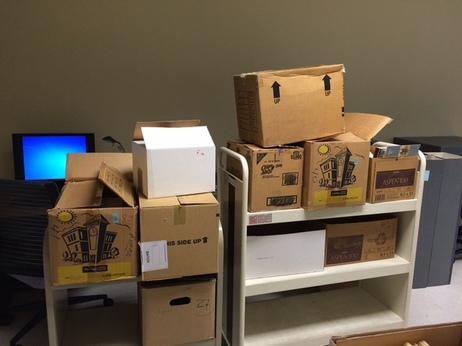
Greetings! My name is Gary Stein and I am a 2nd year M.A. student in History at CGU. My first week working for the CCEPS Fellowship served as a great introductory week to the type of work I will be doing over the course of the summer. As seen in the picture above, Professor Char Miller from Pomona College donated a number of boxes – of materials spanning throughout his life and career – to Special Collections in order to be processed and catalogued. (and apparently there is still more to be donated!) I welcomed the opportunity to go through this collection and process it according to archival standards.
After hauling these boxes up to the CCEPS room, I began reading through the CCEPS documents provided to understand what Archival Processing entails and began to become acclimated with the type of work I will be doing. As an aspiring historian, I’ve become fascinated with archives – not only archival materials, which I have fortunately incorporated throughout a lot of my work at CGU, but also the process involved in obtaining the materials and creating a collection that researchers will be able to use in the future. In creating the collection Char Miller Papers, I hope to become familiar with exactly what that process entails. I think it will not only prove enlightening but could also provide a greater sense of appreciation for archivists and those who work in Special Collections that continue to preserve important historical materials for future generations.
Dr. Char Miller is an historian who is currently Professor of Environmental Analysis at Pomona, where he first acted as visiting professor from 2007 2009. He is also a proud alum of Pitzer College. Within this collection are his various writings including his Senior Thesis, Dissertation, numerous published books and articles, and weekly newspaper and blog entries, among others. It also contains video publications and personal materials from his family.
Well, it did not take me long to begin to appreciate the work that goes into Archival Processing! After getting to know the type of work I will be doing this summer, I conducted an initial collection survey of each of the (12) boxes, going through the materials in each box and beginning to get a sense what type of materials are in the collection and how it will be organized, or arranged. Because this was just the initial survey, I did not examine each folder in each box thoroughly; rather, I took some initial notes regarding each box’s contents and began proposing potential series or groupings based on some initial reactions.
I then transferred the titles of each box’s folders into a Microsoft Excel spreadsheet, consisting of a brief description of the box’s contents and all folder titles, as they were created by Char himself, along with any dates he may have included in the folder titles. I also made sure to take relevant notes regarding certain folders and included them in the spreadsheet. For example, I had to take note of any newspaper clippings within a folder, because I will then need to photocopy them onto acid-free paper (once I go through each folder in greater detail later) in order to prevent any future damage to the other materials in the folder.
An important lesson I learned from my introduction to processing a collection is that it is recommended to try and keep any original titles or order that the creator of the collection (in this case Char Miller) provided. For this collection, Char in fact organized the different materials to a certain extent, which means I will have to try and keep it “as is” as much as possible, as long as it fits accordingly within the processing and arrangement plan I devise. At first, I was a little disappointed with this, only because I thought it would make the work simpler and perhaps not include many of the steps necessary while processing a more “haphazard” collection of materials.
But, these fears quickly went away once I really got started! I understand now that the key job of the processor is to arrange the collection in the most clear and simple way possible, so that it will be easier for researches to navigate through the materials and find exactly what they are looking for. I know as a researcher I would greatly appreciate this as well! Also, as I have gone through the collection initially and worked on the spreadsheet, I am gaining an invaluable knowledge of the work – even if I won’t necessarily have to complete each and every task imaginable! I’ve created my initial arrangement scheme based on the initial survey, organizing the collection through different series, and some subseries, and I am very excited to see if these series will in fact remain or how they will change once I begin to go through the entire collection more thoroughly.
As a distinguished academic scholar, both in history and environmental analysis, and a contemporary writer, Professor Miller stands as a significant originator of the collection. His weekly columns mostly focus on environmental concerns, including Climate Change, and the relationship of the environment with other “hot topics” such as Presidential elections, immigration reform, and the drought in California. Additionally, the collection contains materials from Pomona college including correspondence regarding the hiring process, previous syllabi, and documents related to the development of the Environmental Analysis program at Pomona, a major he helped initiate.
The box of family materials he has donated also seem to be extremely interesting, filled with photos and artifacts! It has been an amazing first week getting acclimated with the process, and has only heightened my excitement for what more is in store the rest of the summer!